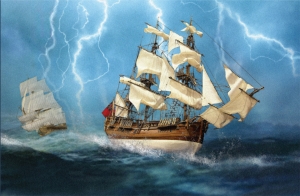 HM Bark Endeavour, also known as HMS Endeavour, was a research vessel commanded by Lieutenant James Cook of the Royal Navy in his first voyage of discovery, to Australia and New Zealand in 1769-71.
HM Bark Endeavour, also known as HMS Endeavour, was a research vessel commanded by Lieutenant James Cook of the Royal Navy in his first voyage of discovery, to Australia and New Zealand in 1769-71.
Renamed and commissioned as His Majesty’s Bark Endeavour, she left Plymouth in August 1768 and reached Tahiti in time to observe the 1769 transit of Venus across the Sun. In September 1769, after setting sail into the largely uncharted ocean to the south, she anchored off New Zealand, the first European vessel to reach the islands since Abel Tasman’s Heemskerck 127 years earlier. On the way she stopped at the Pacific islands of Huahine, Borabora, Raiatea and Rurutu to allow Cook to claim them for Great Britain. In April 1770, Endeavour became the first seagoing vessel to reach the east coast of Australia, when Cook went ashore at what is now known as Botany Bay.
Following this, Endeavour sailed north along the Australian coast. She narrowly avoided disaster on the Great Barrier Reef, and was forced to beach on the mainland for makeshift repairs to her hull. On 10 October 1770, she wallowed into port in the Dutch East Indies for more substantial repairs, and her crew was sworn to secrecy about the southern continent they had discovered.
Once repaired, the ship resumed the westward journey on 26 December, rounded the Cape of Good Hope on 13 March 1771, and reached the English port of Dover on 12 July, having been at sea for nearly three years.
Largely forgotten after her epic voyage, four years were spent shipping Navy stores to the Falkland Islands. Renamed and sold into private hands in 1775, she briefly returned to naval service as a troop transport during the American Revolution and was deliberately scuttled in a blockade of Narragansett Bay, Rhode Island in 1778. The wreck has not been exactly located, but relics including six of her cannons and an anchor are displayed at maritime museums the world over. A replica of HM Bark Endeavour, now berthed alongside the Australian National Maritime Museum in Sydney Harbour, was launched in 1994.

